How to Make Pie Crust: The Ultimate Guide
Learn how to make the absolute best pie crust with this recipe and step-by-step tutorial that creates a wonderfully tender and flaky crust each and every time. From a surprising ingredient to detailed instructions on rolling, chilling, and blind-baking, as well as adaptations for single-crust and double-crust pies, you will never need another pie recipe. Use this for all of your favorite pie recipes; everything from savory pies like quiche to fruit pies, cream and custard pies, and everything in between!
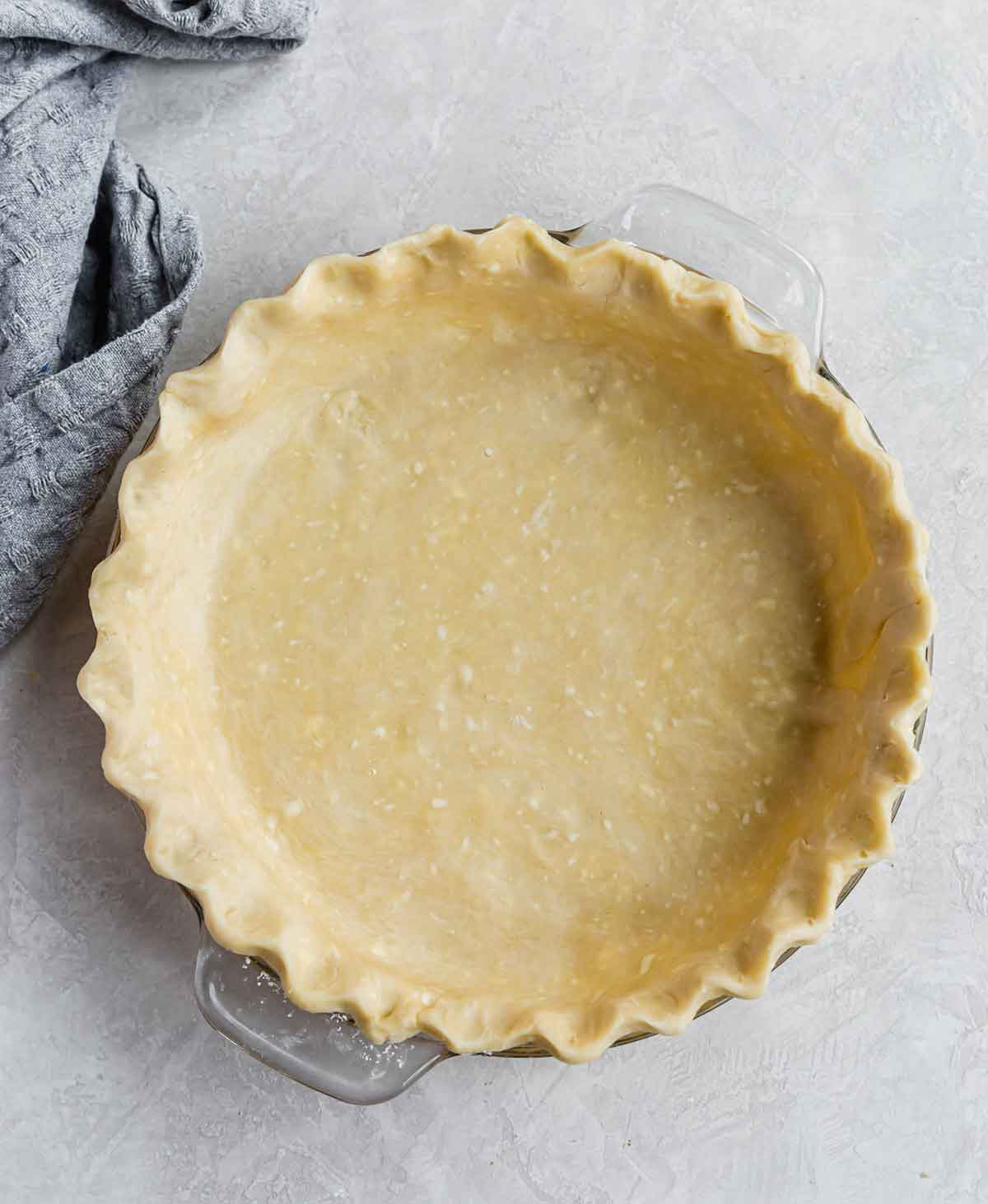
Whenever I ask people what frustrates them the most in the kitchen or what they feel is their biggest baking challenge, two prevailing answers always emerge: yeast bread and pie crust.
It took me YEARS and countless recipes to finally find that one perfect pie crust recipe. It’s the one I use exclusively now – it’s perfect for single-crust pies, double-crust pies, for blind baking, fruit pies, cream pies… for literally any type of pie you want to make.
THIS is best homemade pie crust recipe I’ve found. It’s easy to work with, unbelievably tender and flaky, and it has one surprising, secret ingredient.
Pie Dough Ingredients
It’s astonishing that some pie crust recipes can be foolproof while others turn into a mess when they’re all made with mostly the same ingredients – flour, a little sugar, a little salt, butter and/or shortening, and water. You’ll see that this recipe uses one special ingredient that sets it apart from typical pie crusts:
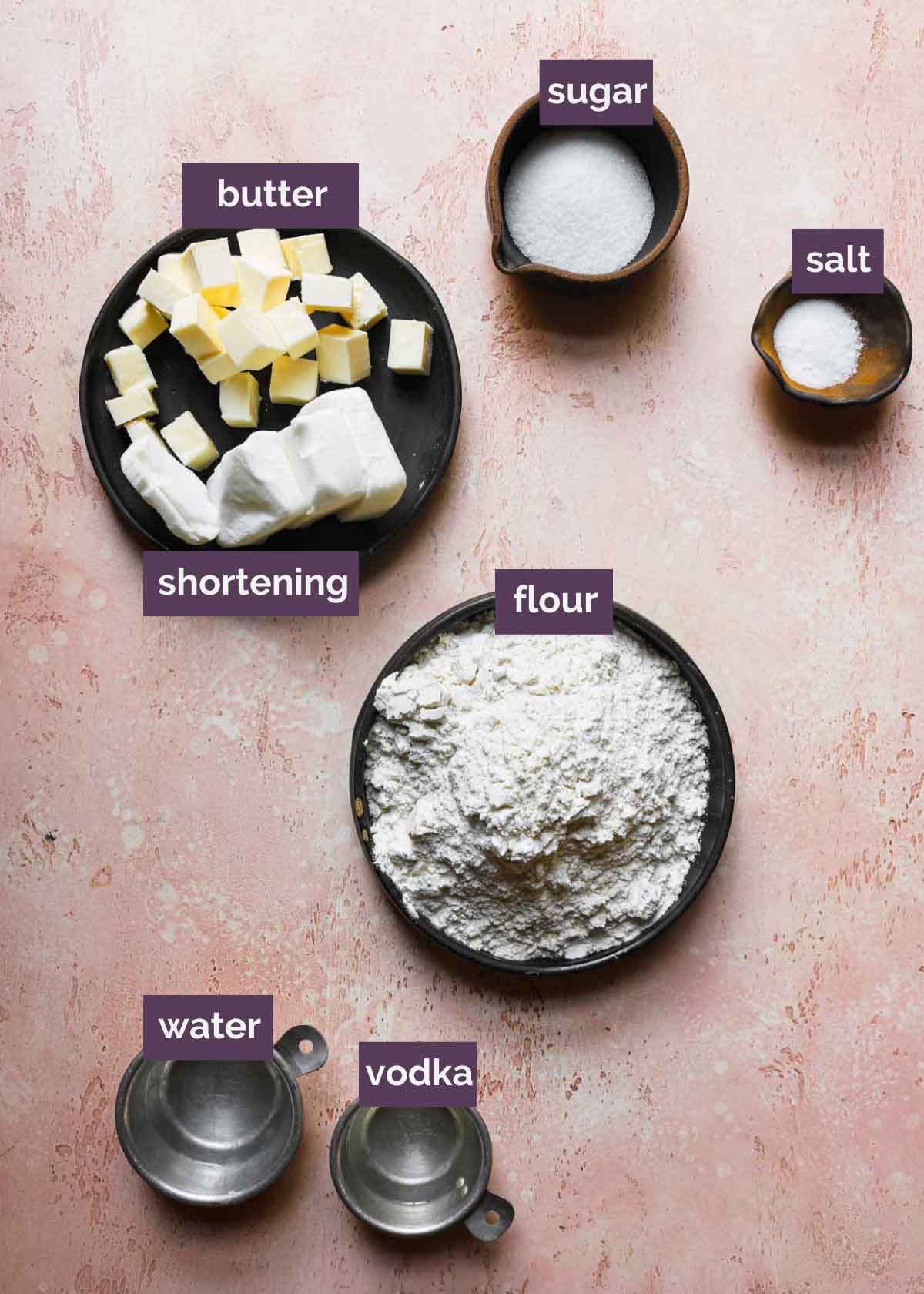
It stands to reason, then, that the trick lies in the ratios and the technique.
Butter vs. Shortening in Pie Crust
You’ll notice that this crust uses BOTH butter and vegetable shortening; I believe the combination results in the absolute best crust that is incredibly flaky, tender, and full of flavor.
- The Butter – This imparts wonderful flavor and incredible flakiness.
- The Shortening – This keeps the crust tender, which means you can work with the dough a little more easily without it falling apart or cracking; it also holds its shape better, which means the perfect crimps around the edges of the pie will stay exactly as you made them and not warp.
I’ve made crusts with just butter, as well as just shortening, and I am a huge advocate of using both together. The balance of the two creates a wonderfully flavorful, flaky, tender pie crust that rolls out beautifully and holds its shape.
If you prefer to just use butter, try my all-butter pie crust recipe.
The Secret Ingredient: Vodka
Well over a decade ago, I was trying my darndest to master wonderfully flaky crust… I had done all butter pie crusts, all shortening pie crusts, using a food processor, mixing by hand, and I was still having mixed results until I tried this recipe from Cook’s Illustrated. Their recipe has a surprising ingredient that shocks most people – vodka.
Why vodka?
When water mixes with flour (as it does in a pie crust), it forms gluten, and too much of it can create a tough crust, which affects the final texture, and can give you fits when trying to roll it out. Using vodka, which is only 60% water, gives the dough the moisture it needs, creates less gluten, and vaporizes in the oven, which means a super flaky pie crust.
Here’s the kicker though – you cannot leave out the vodka or replace it with more water – it just won’t work with this recipe. You can use another 80-proof liquor instead of the vodka, but if you want to avoid alcohol altogether, a more traditional pie crust is probably what you’ll need to go with.
How to Make the Pie Dough (Step-by-Step Photos)
This recipe is written using a food processor, as it works quickly and helps to not overwork the dough since the ingredients are pulsed together quickly, however, you can absolutely make this by hand.
Here’s how it comes together:
- In a food processor, pulse together about two-thirds of the flour, the sugar, and the salt.
- Add the butter and shortening and process for up to 10 seconds, until the dough begins to clump and there are some pea-sized pieces of butter remaining.
- Add the rest of the flour and pulse until the mixture is evenly distributed.
- Empty the mixture into a medium bowl.
- Sprinkle the cold water and chilled vodka over the mixture and use a rubber spatula to fold and press the dough until it sticks together.
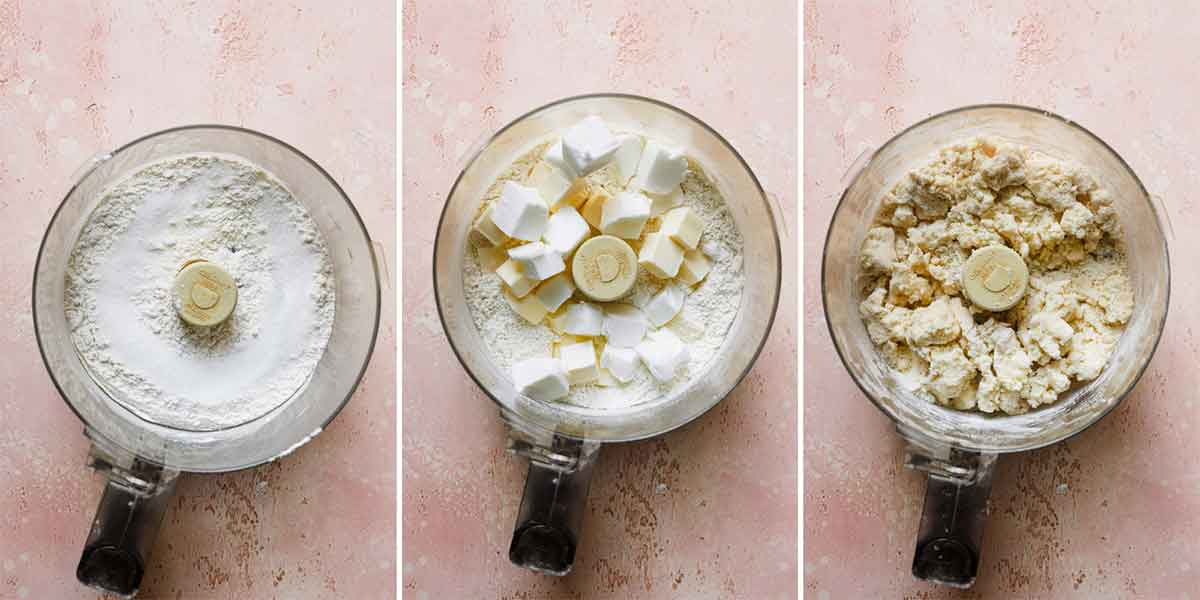
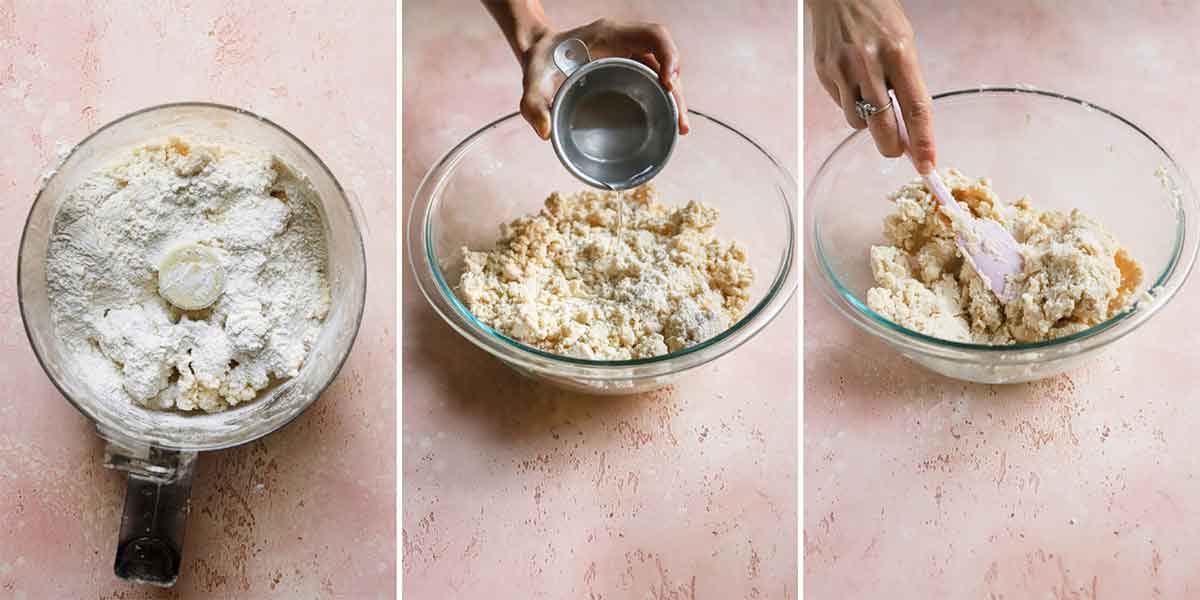
To Make it By Hand:
- In a large bowl, whisk together two-thirds of the flour, the sugar, and the salt.
- Using a pastry cutter, cut in the cold butter and shortening until it is evenly distributed amongst the flourmixture. Then, add the rest of the flour and cut it in.
- Sprinkle the water and vodka over the mixture and use a rubber spatula to fold and press the dough until it sticks together.
Proceed to roll out the crust unless you are planning to freeze the dough for a later date (see freezing directions further below).
How to Roll Out Pie Crust
Don’t be surprised at how soft and supple this pie crust is – it’s much softer and malleable than others you’ve likely tried. It’s okay to add quite a bit more flour when rolling it out, simply brush off any excess when you’re done rolling with a pastry brush.
Dust a clean work surface with some flour and place your pie dough in the center (I personally love using a silicone dough mat with measurement markings for any type of dough work!).
Gently roll the dough into a 12-inch circle. As you’re rolling, dust a little flour as needed and give the dough a quarter turn after each roll to keep it from sticking. Once it’s rolled out into a circle, gently transfer it to your pie plate.
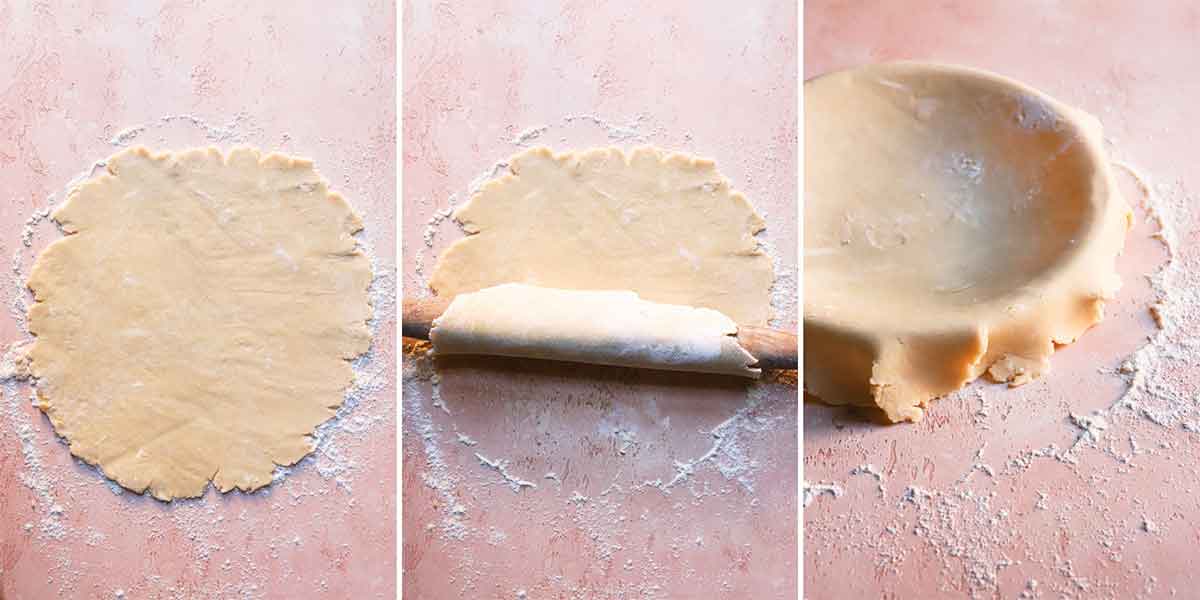
Some people find it helpful to use the rolling pin to help transfer the dough to the pie plate. To do so, gently roll one end of the dough over the rolling pin, pick it up, and carefully roll it off over the pie plate. Try to center it on the pie plate so there is at least a 1-inch overhang around all the edges.
Ease the dough into the plate by gently lifting the edge of the dough with one hand while pressing into the plate bottom with the other hand.
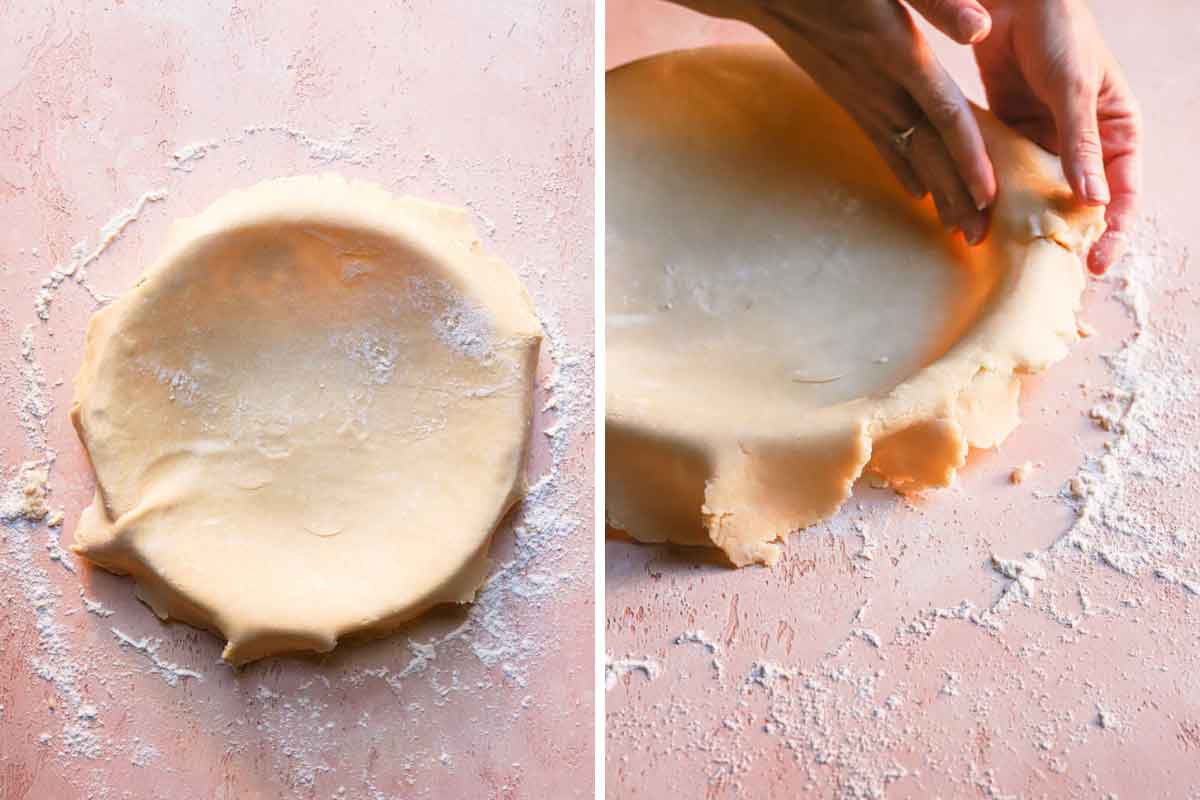
Now Flute or Crimp the Pie Crust
With scissors or kitchen shears, trim the edge so that it overhangs by at least one inch. Fold the overhang over itself to create a thick border that sits on the top edge of the pie plate, not below.
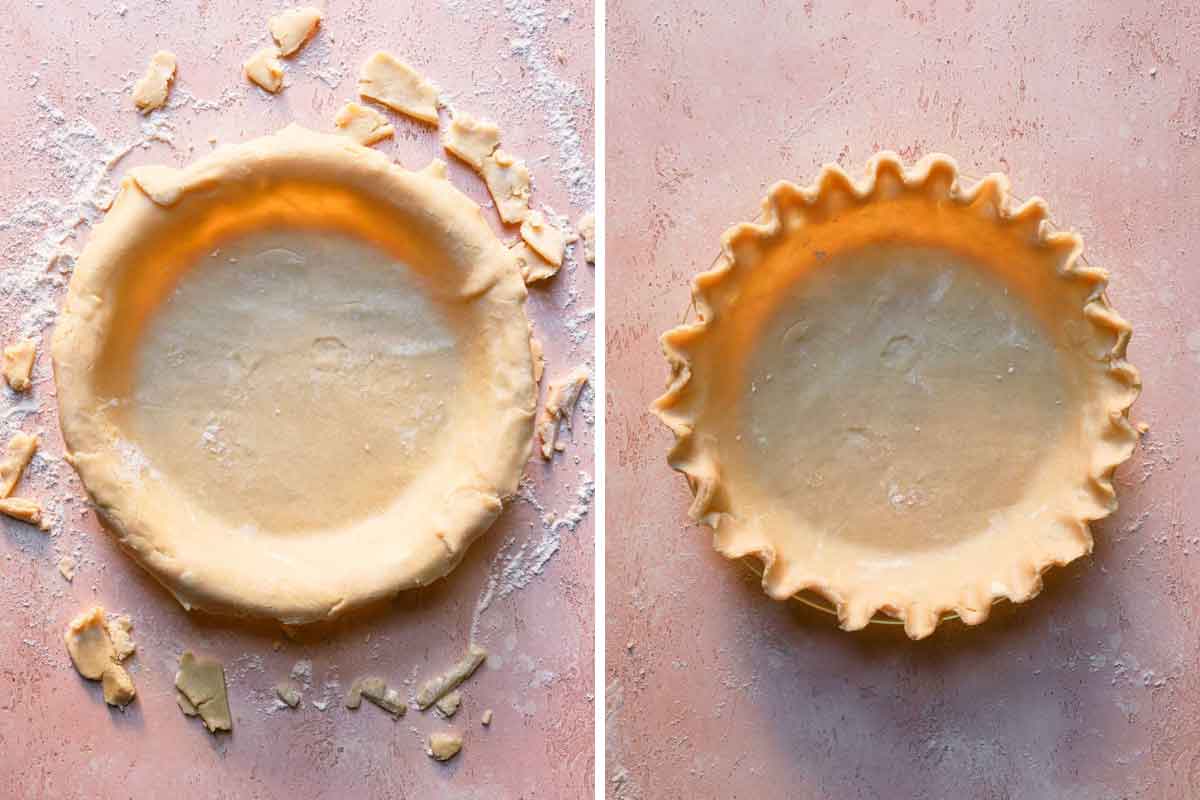
Then crimp, flute, or shape the crust as desired.
To Flute the Crust: Push your thumb or knuckle from one hand in between the thumb and index finger of the opposite. This will give the crust a classic look, as seen in this Dutch apple pie.
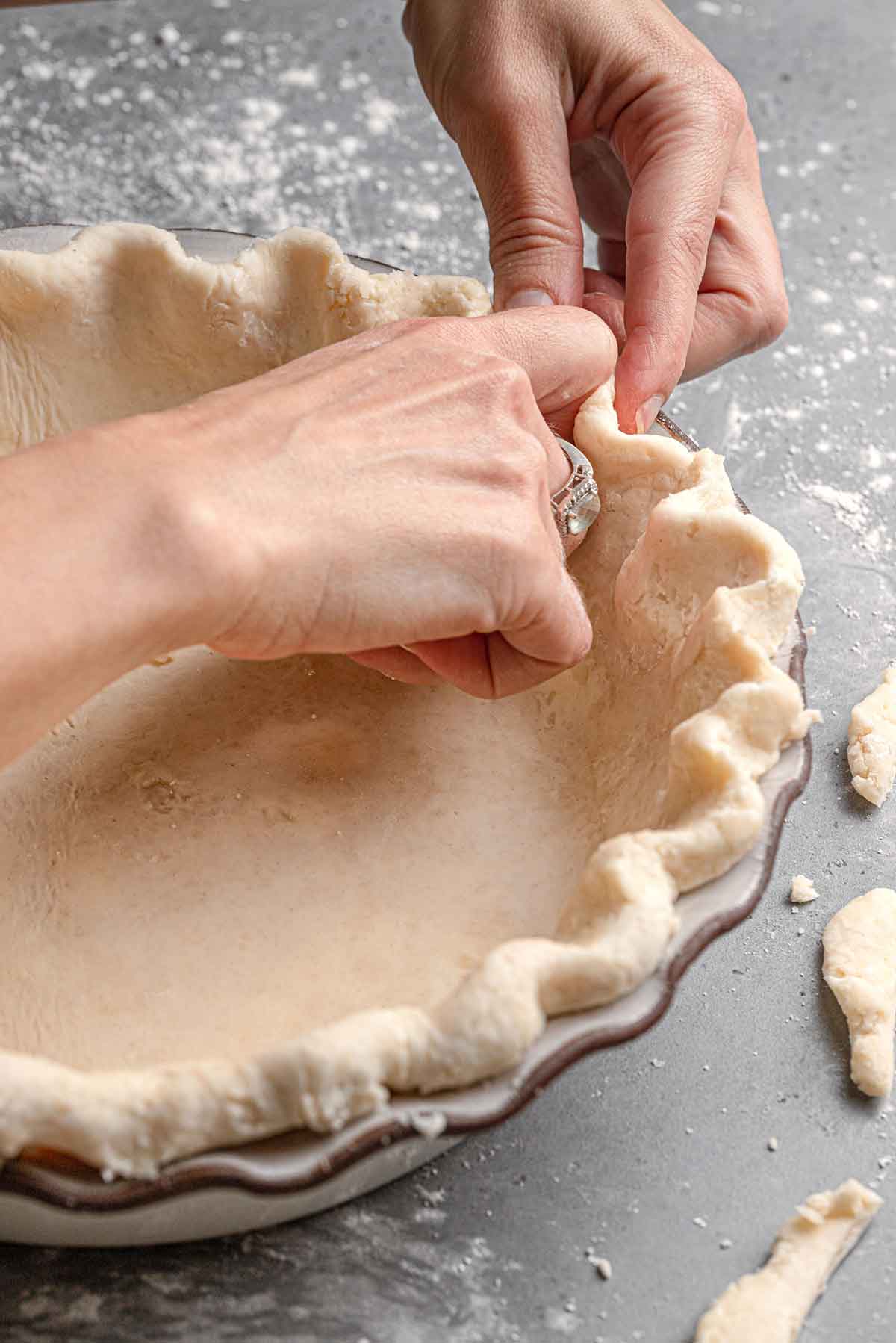
To Crimp the Crust: A simple method for crimping the pie crust is to use a fork; simply press the tines of the fork into the edges of the pie crust to leave indentations evenly around the edge of the pie.
Time to Chill!
At this point, gently cover the dough-lined pie plate with plastic wrap and refrigerate for at least 2 hours, or up to 24 hours, then use it as directed in your pie recipe.
If you will need to blind-bake the crust, see the section below on how to do it…
How to Blind Bake Pie Crust
I always recommend my favorite method for blind baking the pie crust. Be sure to refer to that tutorial if you plan to blind bake a pie crust, but here is a quick overview..
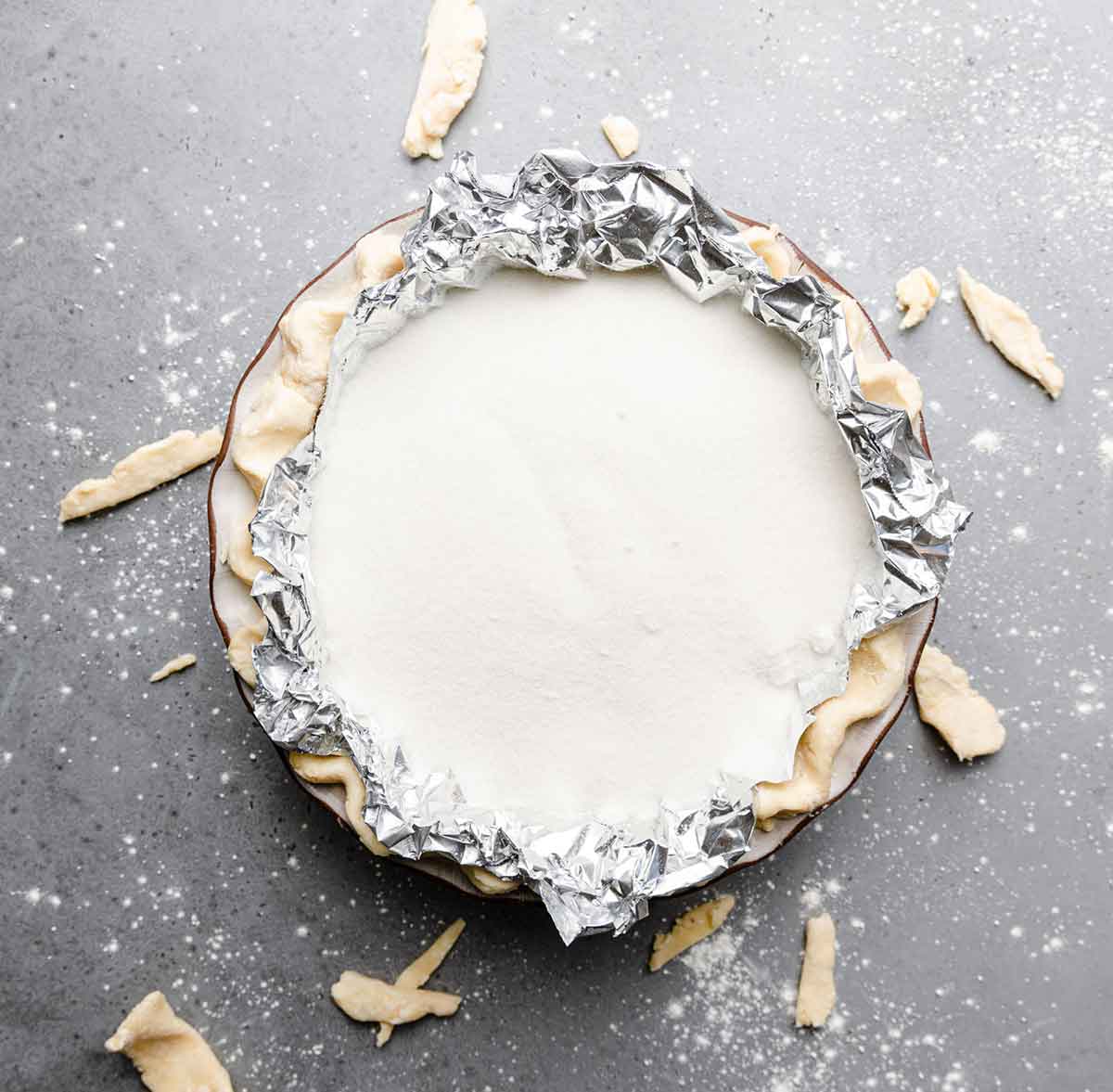
At this point, we have already mixed together our dough, rolled it out, lined the pie plate, and chilled it for at least 2 hours.
You’ll now line the pie dough with aluminum foil and fill it up the whole way with sugar (it is heavier than beans or rice and can fill the entire shell of pie unlike pie weights, all of which ensure that the crust does not shrink and stays put), then do a partial bake in the oven, keeping it covered and weighted the entire time.
I was blown away the first time I tried this method and have used it exclusively since; it creates the most perfectly blind-baked crust! You can see the result of the blind-baked crust below in my French silk pie.
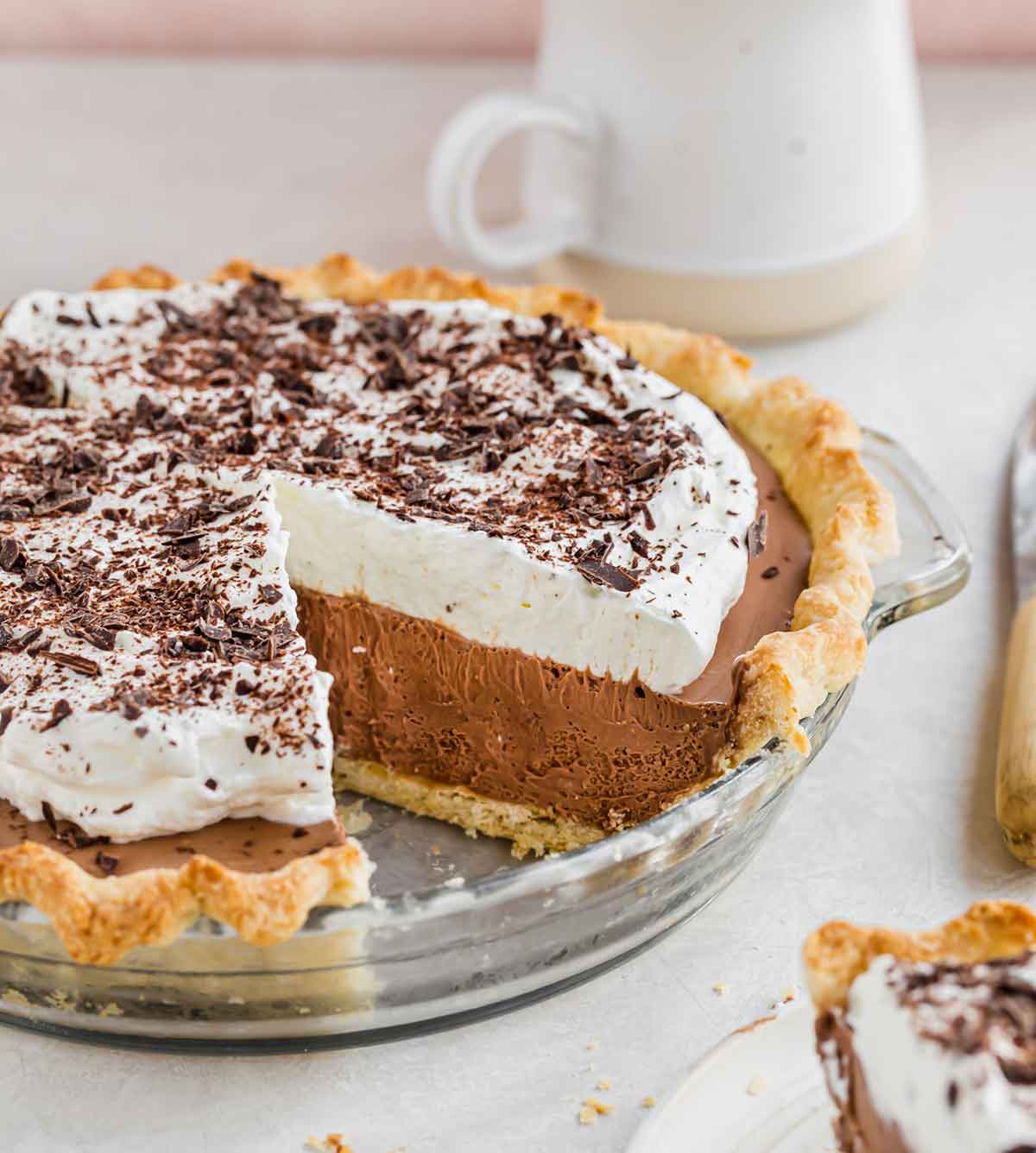
Freezing Pie Dough
Pie crust freezes beautifully and it’s a great way to get a head start on holiday baking.
To freeze your pie dough, once you have finished mixing the dough, turn it out onto a lightly floured surface and gather it together with floured hands, pressing it together into a cohesive ball. Flatten the dough into a 1-inch thick disc and wrap it tightly with plastic wrap. Place the wrapped disc in a freezer-safe ziploc bag and freeze for up to 3 months. Thaw overnight in the refrigerator before rolling out.
Pie Pan Recommendations
First and foremost, you want to be sure you have a quality pie plate. Glass is great for all pies, as you can see exactly what your crust is up to!
I use and recommend a classic glass 9-inch Pyrex pie dish.
There are many different types of pie plates you can use, so if you want to try something other than glass, here are my other recommendations:
- Ceramic Pie Plate – Rose Levy Berenbaum’s Perfect Pie Plate
- Metal Pie Plate – Williams Sonoma Goldtouch Nonstick Pie Dish
Recipe Notes
- Cold ingredients are essential! Be sure to have the butter, shortening, vodka, and ice water as chilled as possible before beginning. Once you start, work quickly and pop the dough back into the refrigerator for 10-15 minutes if the dough is getting too soft or the butter is too warm.
- Equipment recommendations: Pie plate / pastry blender / food processor / silicone dough mat / rolling pin
- Double crust: If you have a pie recipe that calls for a double crust, simply double this recipe. I recommend lining the pie plate but leaving the overhang in place until ready to fill and bake. Roll the second piece of dough out into a 12-inch circle and place on a parchment-lined baking sheet and chill for 2 hours as well.
- Double Crust? Chill Again: If you are making a double-crusted pie, after filling the pie and sealing the crusts together, refrigerate 30 minutes before baking.
- Make-Ahead: You can refrigerate the dough-lined pie plate up to a day in advance of baking. You can also prepare the pie dough and wrap the disk in plastic wrap and refrigerate for up to 3 days. Let sit on the counter for about 20 minutes before rolling out. Once the pie plate has been lined with the dough and the edges crimped as desired, be sure to chill again for at least 2 hours before proceeding with the recipe.
Example of the crust used on a double-crust pie (classic apple pie!) below:
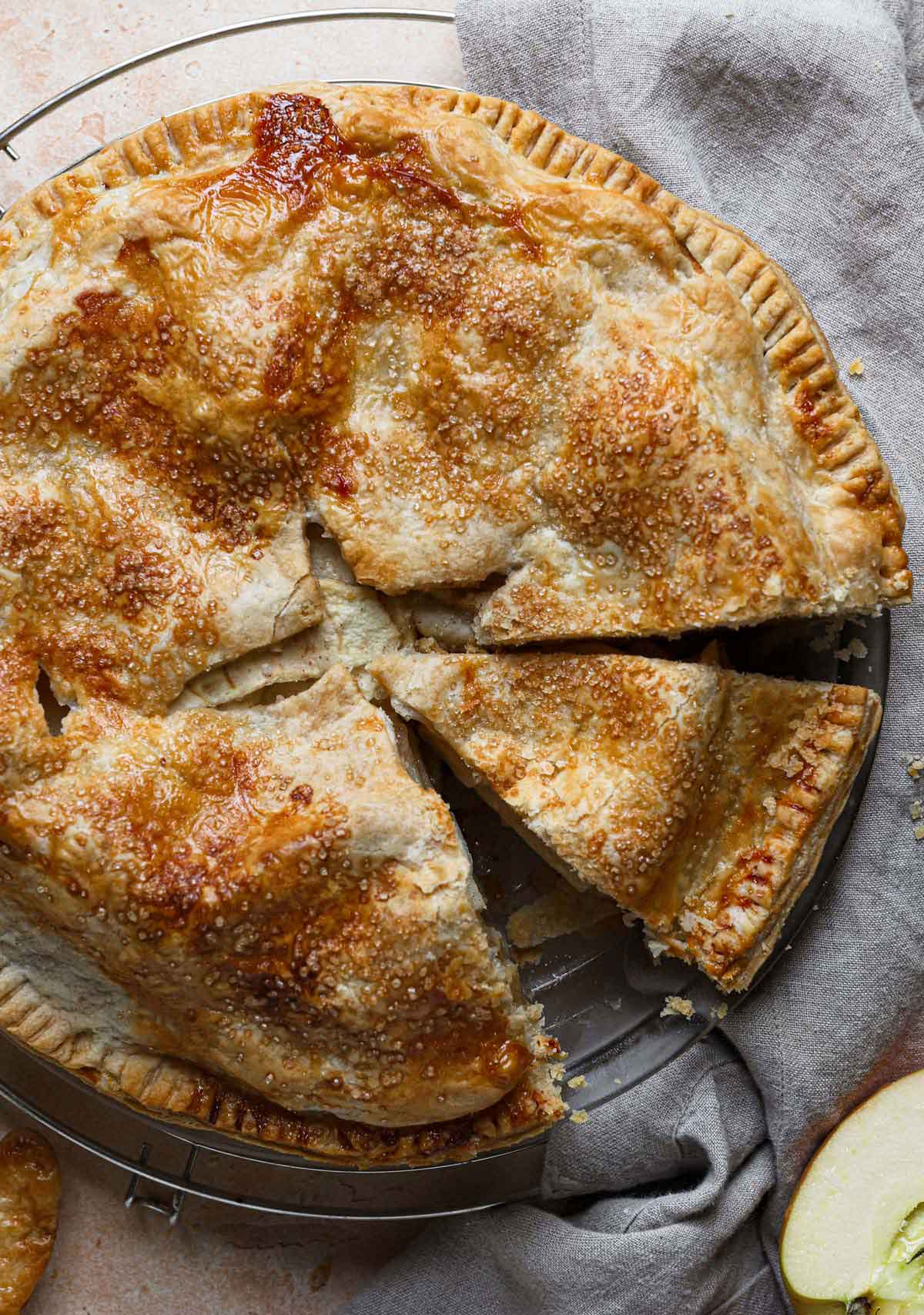
Use This Crust Recipe to Make These Pies (or any of your favorite pie recipes!):
- French Silk Pie
- Salted Caramel Apple Pie
- Perfect Pecan Pie
- Sweet Potato Pie
- Perfect Pumpkin Pie
- Kentucky Derby Chocolate Bourbon Walnut Pie
- Classic Apple Pie
- Fresh Strawberry Pie
- Blueberry Pie
If you make this pie crust and love it, remember to stop back and give it a 5-star rating – it helps others find the recipe! ❤️️
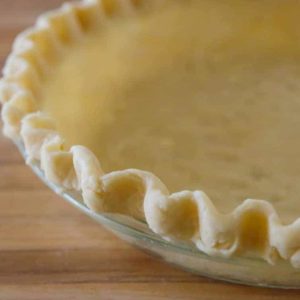
The BEST Pie Crust Recipe
Ingredients
For Single Crust Pie
- 1¼ cups (163 g) all-purpose flour, divided
- 1 tablespoon granulated sugar
- ½ teaspoon salt
- 6 tablespoons (85 g) cold unsalted butter, cut into ¼-inch slices
- ¼ cup (46 g) chilled solid vegetable shortening, cut into 2 pieces
- 2 tablespoons vodka, cold
- 2 tablespoons ice water
For Double Crust Pie
- 2½ cups (325 g) all-purpose flour, divided
- 2 tablespoons granulated sugar
- 1 teaspoon salt
- 12 tablespoons (170 g) cold unsalted butter, cut into ¼-inch slices
- ½ cup (92 g) chilled solid vegetable shortening, cut into 2 pieces
- ¼ cup (60 ml) vodka, cold
- ¼ cup (60 ml) ice water
Instructions
- Food Processor Instructions: Process ¾ cups of the flour, the sugar and salt together in a food processor until combined, about 2 one-second pulses. Add the butter and shortening and process until a homogenous dough just starts to collect in uneven clumps, about 7 to 10 seconds (the dough will resemble cottage cheese curds with some very small pieces of butter remaining, but there should be no uncoated flour). Scrape down the sides and bottom of the bowl with a rubber spatula and redistribute the dough evenly around the bowl. Add the remaining ½ cup flour and pulse until the mixture is evenly distributed around the bowl and the mass of dough has been broken up, 4 to 6 quick pulses. Empty the mixture into a medium bowl.
- By Hand Instructions: In a large mixing bowl, whisk together the flour, sugar, and salt. Toss the butter and shortening with the flour mixture to break up any big pieces. Use a pastry blender to cut the butter and shortening into the flour mixture until it looks like coarse crumbs.
- Sprinkle the vodka and water over the mixture. With a rubber spatula, use a folding motion to mix, pressing down on the dough until it is slightly tacky and sticks together.
- For Single Crust Pies: Roll out on a generously floured work surface to a 12-inch circle. Transfer to a 9-inch pie plate, leaving at least a 1-inch overhang on each side. Working around the circumference, ease the dough into the plate by gently lifting edge of the dough with one hand while pressing into the plate bottom with other hand. Dust off any excess flour with a pastry brush. With scissors or kitchen shears, trim the edge so that it overhangs by 1 inch. Fold the overhang under itself; the folded edge should be flush with edge of pie plate. Flute the dough or press the tines of a fork against dough to flatten it against the rim of pie plate. Wrap with plastic and refrigerate at least 2 hours and up to one day in advance. Use as directed in your favorite recipe.
- For Double-Crust Pies: Divide the dough into two portions. Roll one out on a generously floured work surface to a 12-inch circle. Transfer to a 9-inch pie plate, leaving at least a 1-inch overhang on each side. Working around the circumference, ease the dough into the plate by gently lifting edge of the dough with one hand while pressing into the plate bottom with other hand. Dust off any excess flour with a pastry brush. With scissors or kitchen shears, trim the edge so that it overhangs by 1 inch. For solid top crust, roll remaining dough as before (into a 12-inch circle); for a lattice-top pie, roll it into a 9- by 15-inch rectangle instead. Transfer to a parchment-lined baking sheet. Wrap both portions in plastic wrap and refrigerate for at least 2 hours and up to one day in advance. Use as directed in your favorite recipe; after filling the pie and sealing the crusts together, refrigerate another 30 minutes before baking.
- For Blind-Baked Pie Crust: Adjust oven rack to lower-middle position and preheat to 350 degrees F. Remove the chilled pie shell from the refrigerator and line with a large sheet of aluminum foil, pressing it so it conforms to the pie plate, and over the edges of the pie. Fill the whole way to the top with white granulated sugar, then transfer the pie plate to a rimmed half sheet pan and bake. For a par-baked pie crust (one that needs to be filled and then continue baking), bake for 40 minutes; remove the foil and sugar and set the crust aside while you make the filling. For a fully baked pie crust, bake for 55 to 60 minutes, remove the foil and sugar, and proceed with the recipe as directed.
Notes
- Equipment recommendations: Pie plate / pastry blender / food processor / silicone dough mat / rolling pin
- Vodka – The vodka is essential in this particular recipe and cannot be substituted with more water. If you do not have vodka, use another 80-proof liquor. If you do not want to use alcohol, I recommend using my all-butter pie crust.
- Cold ingredients are essential! Be sure to have the butter, shortening, vodka, and ice water as chilled as possible before beginning. Once you start, work quickly and pop the dough back into the refrigerator for 10-15 minutes if the dough is getting too soft or the butter is too warm.
- For a Blind-Baked Pie – To carefully remove the foil and sugar, fold and gather the foil towards the middle, then use both hands to carefully transfer to a heat-safe bowl. Let cool completely. Fold long sides of foil toward middle, gather short sides, and use both hands to carefully transfer sugar to heat-safe bowl. Let sugar cool to room temperature.
- Make-Ahead: You can refrigerate the dough-lined pie plate up to a day in advance of baking. You can also prepare the pie dough and wrap the disk in plastic wrap and refrigerate for up to 3 days. Let sit on the counter for about 20 minutes before rolling out. Once the pie plate has been lined with the dough and the edges crimped as desired, be sure to chill again for at least 2 hours before proceeding with the recipe.
- Freezing Instructions: To freeze your pie dough, once you have finished mixing the dough, turn it out onto a lightly floured surface and gather it together with floured hands, pressing it together into a cohesive ball. Flatten the dough into a 1-inch thick disc and wrap it tightly with plastic wrap. Place the wrapped disc in a freezer-safe ziploc bag and freeze for up to 3 months. Thaw overnight in the refrigerator before rolling out.
- Recipe adapted from Cook’s Illustrated.
Did you make this recipe?
Leave a review below, then snap a picture and tag @thebrowneyedbaker on Instagram so I can see it!
[Photography by Dee Frances]


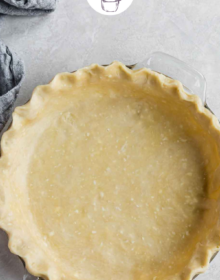



I intended to put you this tiny observation to be able to thank you as before for your magnificent tricks you’ve contributed in this case. It is simply strangely generous with people like you to supply publicly what most people could possibly have distributed for an e-book to generate some money for their own end, most notably now that you might well have done it in the event you decided. These things in addition worked like the great way to realize that other individuals have similar interest really like mine to figure out a whole lot more with regard to this problem. I am sure there are some more enjoyable sessions ahead for folks who see your site.
Thanks – Enjoyed this article, can I set it up so I get an update sent in an email every time you make a new post?
I’ve used this pie crust recipe ever since she first posted it, a few years ago, and it’s the best! It comes together nicely and handles well. It’s about time to start thinking about my Thanksgiving pies!
I use a pie crust recipe that calls for vinegar which I believe retards gluten formation like the vodka in your recipe. It also has 1 egg and always comes out great. I roll my crusts between plastic wrap, two pieces overlapping long ends on bottom, and two on top. I never have to add more flour. Just remove the top pieces, flip onto the pie plate, then peel off the bottom. Totally enjoy your recipes, instructions and tips…
My dough is so soft I can’t roll it. I added more flour, and put back in the refrigerator
Best pie crust ever. How do I defrost your frozen pie crust! I froze a double recipe for later use. I need it for st. Patrick’s day.
Thank you Michelle! Your recipes are the best. My family loves all that I make!
How would you adjust for a 10 in single or double crust?
Only one recipe I use now
Hi Michelle, for a lattice-top pie, would you make the same amount of dough (double the recipe) as you would for a double-crust pie? Thank you!
Yes, I would!
I have made this countless times over the past 7 years. It’s flawless and better than more intensive crusts even when compared side by side! I also use this crust (omit sugar) for chicken pot pie.
I have not gotten a brown eyed baker in months if not years…I am glad to see your name and hop that I get Friday thing also Thank you for so many good recipes
I am making the pie crust for a cream pie, how much would I heat the oven and how long I will bake it?
Thanks
Antoinette
Can pastry flour be used (some or all) in this crust?
Hi Lorraine, I haven’t used pastry flour, so I could not say for sure.
Could I substitute with 1for1 gluten free flour?
Hi Jessa, I haven’t experimente with gluten free flour for this pie crust; if you give it a go, let me know how it turns out!
I have always made pie crusts in my KitchenAid mixer because I don’t own a food processor. Will a mixer work with this recipe?
Hi Linda, I’ve never used a mixer for pie crust, but if you’ve always had success with it, it should work!
Want to try this recipe. Can I use only unsalted butter? I will be waiting for your response. Thank you!
Awwww girl!! WOW!! AWESOME!! DO NOT even begin to cover this or any of your recipes I’ve made and tried!! HOLY SMOKES not even close! I missed your post about the pix & Instragram but it won’thappen next time and there WILL BE a next time 😉😁😉 Did you by chance sometime back say something along the lines of “You wish you could be a Southern girl with all the wonderful Southern RECIPES you’ve made and loved?” Because if this is you, “Darlin’ consider yourself a Southern Belle. WELCOME TO THE SOUTH KATIE SCARLETT O’HARA!!
This crust is amazing!!
Best pie crust I’ve ever made. So flaky. Thanks for sharing.
The pie crust with vodka is fabulous. Forming less gluten makes a lot of sense. The joy is that the pastry is so malleable that if you mess up getting it into the pie plate, it is really easy to pat it into shape. May never make a different pie crust again. *****
Hi
I can not find vegetable shortening so could i swap it for butter? Im in a Rush to try this pie crust cos I never made a really good one thanks :)
You can use all butter – it will be more flaky and you’ll lose some of the tenderness, but it should still work.
Hi! I made 2 batches of your pie crust. I was wondering if I could freeze it til I need it for next week!
Hi Cindi, Yes, it freezes exceptionally well!
This recipe is a revelation to a long time baker! Excellent results on the first try. The only downside I can see that it could be a bit intimidating to someone who is not experienced with pastry. The instructions though do make it clear that the dough will be very wet and that adding a generous amount of flour during rolling will not be a problem as it ordinarily would. I actually added a small amount of the liquid while the dough was still in the food processor and I think it may have it sped things up a bit but the time I then had to spend getting it out of the bowl probably was a wash. Great flaky crust, even the bottom on my lemon chess pie. Thank you!
Why isn’t there cooking time and temperature listed for the crust.
Hi Jim, It will depend on the type of recipe you are using the crust for, which is why you should follow the baking temperature and times for a specific pie recipe.
Absolutely the best pie crust ever! Everyone raves about the crust. Easy to deal with. Thank you!
I didn’t have vodka so I used Tequila. Best pie crust ever! So flakey and fluffy at the same time. Even my kids noticed the difference.
Best crust ever! Thank you for sharing!
I made this crust tonight. It’s a good crust but I didn’t feel that the vodka made a huge difference in the taste of the crust. It was ok.
The first time I made this crust, I made the single recipe and it turned out perfect. Today I doubled the recipe with exact measurements and the dough seems dry and not together as well. Will let you know when I roll out!
Would 40% Vodka work just as well? What would the difference in the pie crust be?
Hi Sheila, I think it would still be okay. The difference is that 40 proof vodka contains half as much alcohol as 80 proof, meaning it contains more water. Water contributes to the creation of gluten (too much of which can cause crusts to be leathery), while the alcohol simply evaporates in the oven, leaving the crust light and flaky.
Now how to keep it from getting soggy when making lemon meringue pie?
Oh bummer! I’ve never had this crust get soggy! Maybe try blind baking a bit longer to get it crisper before filling?
I make this with a slight difference. I freeze the butter and shred it in the food processor, change to the mixing blade and finish the same way you do. It is so easy and makes a big difference.
Can this crust be frozen?
Yes, absolutely!
This was fantastic will never use another
Does 100 proof vodka work in this recipe, or does it have to be 80 proof? I ask because you mention that another alcohol could be substituted if it were 80 proof.
Hi Marilyn, I think 100 proof vodka would be fine.
I made this pie crust for my Thanksgiving pumpkin pie and everyone loved it. The dough was very easy to work with and it was definitely more flaky. I would leave a pic but my edges were a little wonky to say the least! Thanks for the recipe will use again.
I wanted to follow up! I made this for a chocolate pie and it was amazing. It looked far from amazing because my technique stinks but I’ll keep working on it. I also needed to blend it more in the food processor because my butter chunks were too big and left little pools of butter after it baked. I do have a question. I used beans to keep the crust flat when it baked, it seemed like the crust didn’t cook as much under the beans. I didn’t use a lot, just enough to cover the bottom. I had to cook it longer after taking the beans out. Any thoughts? Thank you for the recipe!
Hi Beth, Hmm I’ve never used beans so I can’t say for sure. This is the pie weight that I use – http://amzn.to/2fqwvmV – and I’ve never had any issues.
Hi! I forgot to buy shortening, can use all butter?
Hi Crystal, You can, the texture just may end up a little bit different.
I used this recipe this Thanksgiving and, after baking pies for over thirty years with a traditional recipe, this was the absolute best. I had tried the vodka method a while back and wasn’t impressed but this combination of sugar, butter and shortening was outstanding. I will need to adjust and shorten the cooking time as it browned a little faster than expected, but, as my family said, “make sure you overcook it again next time”- it was that good. Thanks, Michelle!
You’re so welcome, Barbara! I’m thrilled to hear you and your family loved it as much as I do.
How long do i cook the crust for?… i don’t see it anywhere. I’m not planning to add the rest of my ingredients yet… Can you let me know?..
Thanks!
Hi Sandra, You should just follow the instructions for whatever pie recipe you’re planning to make.
Ok, I think I may have solved my problem! I made another batch (I am doubling recipe for double crust pies) and didn’t process the flour/butter as long the first time or after adding the remaining flour. This definitely made the “dough” dryer and crumbly and then when I added the liquid it worked fine. I must’ve just been getting a little too heavy handed on the food processor!!
Hi Juli, Awesome to hear!!
Ah! Maybe that was part of my problem, too. Thanks!
Only have salted butter. Is that ok to use?
Hi Gina, Yes, that would be fine, just omit the salt in the recipe.
Thanks for sharing! I attempted this recipe without a food processor and used a dough blender. Everything went well until I baked the crust, I experienced major shrinkage (sad face). Any advice on how to prevent this from happening? Thanks!
Oh no! This is the recipe I’ve never had a shrinkage issue with. I use this pie weight and love it – http://amzn.to/2fqwvmV
I’ve read others’ comments about the stickiness of the dough. Once I put all the liquid in, the mixture is literally in a pool of it! I’ve had to add at least a couple TBL of flour just to get it together. Is yours like this??
That is how mine was. I kept folding it over and eventually it seemed to not be sitting in liquid however very sticky and wet. I did not have saran wrap so sprayed foil with non stick spray lol. They turned out great, it gives you the chance to use ample flour when rolling it.
Hi Juli, I’ve never had a pool of liquid, but yes, it is a much wetter, stickier dough.
My dough seems very wet and sticky is it supposed to be? I made it tonight to make pies tomorrow. Also I only have aluminium foil so that’s what I covered it with and put it into a Ziplock. I have never made homemade pie crust before and hope it turns out well.
Hi Amanda, It will be a little sticky when you first mix it together. Just use as much flour as you need tomorrow when rolling it out so it is workable.
Well I made them and I tasted a bit of crust it is very good! My problem is that the crusts shrank in! I feel I needed more dough I rolled it rather thin but could not obtain a 12 in circle. Also I am terrible at fluting it. All in all, not bad for a first time.
See the comment I just posted….
Hi Michelle. I made this crust last night, to try out ahead of time for Thanksgiving. I let it chill about an hour. It was very sticky, and hard to work with. I ended up pressing in the pie plate. I did use the extra 1/4 c flour. I do not have the mat, to roll the crust on. I always roll my crust on my granite counters and I have no problems. My crust literally stuck to counter, but the crust was delicious, so light and flakey. What can I do to keep it from sticking? I am going to buy a pastry mat today, but I’m not sure if that is going to solve my problem! What did I do wrong?
Thank you!
Hi Chris, I would use as much flour as you need to make it workable and not sticky. It is definitely a softer dough, which can take some getting used to, but that’s why the extra flour is factored in.
Hi! I had the same problem. I wondered if the measurements may have been off in the post, but maybe it was just something I did. I doubled the ingredients, and it was almost a paste. It was so gooey that I had to add enormous amounts of flour, and it still ripped. Any thoughts on what I may have done wrong? Should I chill the shortening as well as the butter?
Hi Shana, Yes, the shortening should also be chilled (it’s stated in the recipe). If you’re finding that the dough is paste-like and gooey, I would recommend only pulsing in the food processor (instead of letting it run, so you have more control) until just combined, not letting it get to a paste consistency.
I just practiced this today to use for Thanksgiving next week and it turned out great! I’ve always used your other pie crust recipe (all butter one) and while it tasted great it was always difficult to work with. Thanks so much for posting this just at the right time and helping me find my new go to crust :)
I’m planning on making the Apple slab pie for Thanksgiving. Shall I use this pie dough recipe for it? I’m guessing the recipe may need to be tripled. Or do you recommend using the one with the Apple slab pie?
Thank you!
Hi Toree, I would use this one and, yes, I would triple it!
Thank you very much for your response!
When making a savory pie, should I remove the sugar from the crust recipe?
I love your blog! When searching for a recipe, you are my go to site. Thank you! Can’t wait to try the pie crust.
Hi Marcia, Thank you! I wouldn’t remove the sugar; it helps to balance out the flavors. It does not make a “sweet” crust.
I was wondering if you could replace the shortening with an extra quarter cup of butter? Thanks!
Hi Katherina, I’m not sure how that would affect the crust’s texture both before and after baking.
Do you find that one kind of pie pan works better for this crust? For instance glass vs metal? I love to make pies, but what keeps me from making them more often is that I’m “crust challenged “. This one looks easy, good, and probably the one for me.
Hi Donna, I’ve only ever used glass or ceramic pie plates, never metal. I personally like glass the best!
Hi- I prefer to use lard rather than shortening in my pie crust. The newest studies indicate that it is a healthier choice than vegetable shortening. If I substitute lard will the recipe produce the same perfect crust?
Hi Kim, I think lard would work just fine in place of the vegetable shortening. Enjoy!
The perfect pie crust is so elusive. I come from a family of pie making geniuses and the pie making gene somehow skipped me. I have friends who swear by the addition of vodka to their crust as well. I will have to try this one! I love pie and am frustrated with some of the crust results I have tried. Fingers crossed!
Nice idea! I love it!
Michelle, did you see this one?http://recipes.177milkstreet.com/recipes/pie-dough
I did just see that (got the inaugural issue) – need to give it a try!
I need a recipe without dairy- would this work if I substituted vegetable shortening for all the butter?
Hi Karen, I do know of people that use all shortening, but I much prefer a crust with some butter. I’m not sure how the altered fat content would affect this particular crust recipe.
Thanks! I will let you know if I try it.
I also use this recipe but I do have a problem with the pretty edge losing its definition when it bakes! It’s great to roll out and so easy easy to work with but that’s my only complaint.
Looks fabulous! Definitely trying for my apple pie this weekend.
On another note, when I try to print the recipe (and others), it prints out as a series of boxes rather than words. I tried on different computers and printers, and still the same. I’ve not had a problem before, so I wanted to let you know!
Whenever I see pie crust recipes, I think of the bloopers from the Dysart’s restaurant commercial–“Baked in a buttery, flaky crust.” Makes me laugh every time. :)
Hi Michelle, I can’t wait to try this crust recipe. I was just looking at the many pies you have listed on your site today (salted caramel, maple apple, etc) and see that you use different crust recipes. I was wondering if you would recommend using this “best pie crust recipe” for any and all pies?
Hi Juli, Yes! I use this for all of my pie recipes now!
Wow can’t wait to make this, thanks!
Yes, this Cook’s Illustrated is the best. This is my favorite pie crust recipe And if I should space it and use a different recipe, my family definitely notices!
Hi! I was wondering if all the alcohol evaporates while baking? Thanks and I love your blog!
Hi Fatima, Yes it does evaporate.
This is quite interesting! I have never heard of using vodka in a pie crust recipe. And I have always read, and therefore thought, that the way to a flakey pie crust is to not overwork the dough. Overworking the dough is what causes it to be tough. And I found by coincidence once, that using a bit of butter to make up the total amount of shortening called for makes it even flakier (I ran out of shortening and used butter to finish out the required amount.).
But you say it’s the vodka that creates the flakiness? I may have to give this a comparison try. Thanks for the info. Your crust looks perfect!
Hi Michelle, Butter definitely makes it flaky! And shortening makes it tender, which is why I like the combination of the two. But the vodka helps to keep the dough from becoming tough AND it aids in the flakiness.
This is the recipe I use! One thing though. When I try to decorate the edges it almost seems too soft. It’s hard to make them look nice. Any suggestions? I’m actually making this crust tomorrow to use for sweet potato pie!
Hi Lisa, In step #4, if the dough seems too soft after you fold the dough underneath itself, then I would refrigerate again for a little bit until it’s a bit firmer and you feel you can work with it easier.
I was kicking myself after reading your comment. OF COURSE I should stick it back in the fridge. FYI, I did this for the pie I made for Thanksgiving and my pie turned out beautiful. Thank you!!!
Michelle I would love to know if this dough has worked really well for you when it comes to blind baking, specifically regarding side slump. I’ve been on a mission lately trying to find a recipe/technique to eliminate the slump (using ample pie weights). My previous go-to recipe was Kenji Lopez-Alt’s Easy Pie Dough (he was the one who developed the vodka crust recipe for CI but then came up with the Easy version after that) but I primarily use it for things like pot pie that don’t involve blind baking. My most recent attempt (Bravetart’s Old Fashioned Pie Crust) was the most promising so far but if this one doesn’t slump then it’s the next one on my list to try!
Hi Emilie, I don’t have any issues with slumping (FINALLY!). I will also add that I use this Chicago Metallic pie weight when I blind bake.
Thanks for the reply, Michelle, I know you’ve got your hands full these days! :) I’d wondered about that pie weight when it came out — do you leave it in the entire time you blind bake?
I do! Unless the recipe says to remove foil and weights at some point.
What is slumping?
When you blind bake a pie and the crust shrinks and slides down the sides of the pie pan.
Last year when I was unemployed for a brief time, I decided to make a study of pie and perfect my technique and recipes. I made MANY over the course of 3 months and tried several recipes with vodka. But in the end I liked Martha Stewart’s the best and found it most reliable. (Who am I to argue with Martha??) so if you haven’t tried hers, I recommend it.
Is it the all-butter one? If so, I have made it and I think it’s DELICIOUS! However, I still think this one is the most consistent and by far the easiest to work with.
Yes-all butter. Sometimes I think the shortening gives it an ‘off’ taste. I guess it’s all in the balance. I also recommend the Pie Academy website by Ken Haedrich for all things pie. And the Hoosier Mama cookbook (the chapter on desperation pies is a hoot!). As I said, I made quite a study?
Ditto on the Pie Academy website. His book Pie is a great resource too.
I have to second Martha Stewart’s Pate Brisee recipe! I used it for years and it came out perfect every time! Last year, I decided to try a half shortening/half butter recipe and it was a disaster (the ratio of fat to flour was waaaay off)! I have been wanting to try the vodka recipe for a few years now, so maybe this year I will give it a go. If not, back to the no fail Pate Brisee for me!
I love this most reliable pie crust since Cook’s Illustrated discovered the value of adding vodka with the water to the dough to produce the easiest pie dough to shape & then the tastiest and flakiest perfect pie crust ever!
I don’t have a food processor? What would work as an alternative?
Hi Stacie, You can whisk together the dry ingredients, then use a pastry blender to work in the butter and shortening, then proceed as directed in the recipe.
WOW! I cannot wait to try this recipe. I have a fave go-to pie crust recipe that never fails me but I always like to try new ideas because I hate to miss out on something AMAZING. I will be checking back to see if you are able to respond to some of the questions posed by other commenters. Thanks for sharing this!
YES!!! I Love using vodka!! Also I always put the water/vodka mixture in the freezer so it gets super cold to match with the other super cold ingredients. Vodka doesn’t freeze so the mixture gets extra cold and I don’t have to worry about leaving it in there too long! Love this recipe!
Thank you, Catherine. I just made and froze 8 crusts using my usual recipe. But I look forward to trying out this “vodka on the rocks” recipe!
My trick is.. cold vinegar…gives the same flaky results,
Can the dough be frozen if it has the alcohol in it?
Yes, absolutely!
I’m going to try this recipe for my first homemade crust this Thanksgiving! Do you think trying one of the flavored vodkas would add any taste? Like the Pinnacle Pumpkin Pie or other flavors for other pies? Just curious.
Hi Beth, I don’t think they really do. I’ve substituted citron vodka when I’ve been out of regular, but haven’t been able to pick up on any flavor.
Have to try the Vodka, I have one pie crust recipe that uses egg yolk and vinegar, its the most moist flaky crust I have ever made and not a bit dry.
Is it possible to come back to this recipe again and show us–step by step, close up photos, for the technique you use to flute the crust with your fingers. I never know where to put my thumb and how to press the crust to make it look like that. Your final result is gorgeous. I love to make pies from scratch, especially Pumpkin, but my crust is never very appealing. Oddly enough, people always know my pie IS homemade just from the appearance of the crust. LOL. ?
My remedy is to make a double crust and use the second crust for “leaf” cutouts from Sur La Tab. I then use up the entire second crust with the cut outs and cover my ugly duckling flute job with the leaves!! Or in Winter, I use their snowflake cookie cut outs. The mini size.
I have to say, there are times where I would just like to “flute” a beautiful crust and present my pie as is. Simply Gorgeous !!
Also, I see you use the KAF mat. Does it lay nice and flat for you?
I have a similar one, not the KAF name, and I literally have to tape it to my counter to stay flat. It wants to roll back up on me. I spend more time fighting with the mat than I do rolling the crust.
Thank you for your help!
PS. Congrats on the KAF Guest Baker !! Nice Post !!
Hi Brenda, I will work on a tutorial, thank you for the suggestion!! And thank you!
I second this poster’s request! Haha!! I do the exact same thing with the cutouts to hide my embarrassing flute job! I use this recipe for my pies and after years of failure, I finally have a crust whose flavor I am proud of, but presentation, not so much ;)
Try YouTube for fluting instructions. They have tutorials on just about everything!
Can this be done without a food processor? I don’t have one, but am looking for a pie crust recipe.
Yep, I don’t have a f.p. either. Can I just use 2 forks? I remember reading to use Vodka before (and I’m Russian so the Vodka thing should come natural) but didn’t because I didn’t know why and never have any in my house. But my neighbors will have some. I spent one day over 2 hours surfing youtube to find the perfect crust recipe! I cannot wait to try this. Not only great for fruit pies, but chicken pot pie!!!
Hi Lisa, Yes! Just whisk together the dry ingredients, then use a pastry blender to work in the butter and shortening, then proceed as directed.
Thanks for posting. The timing couldn’t be more perfect. The edge on your crust is perfection. I really need to get the patience to be able to do that.
My favorite as well.
Do you think this will work with gluten free AP flour? Thanks!
Hi Lisa, I’ve never worked with gluten-free flour so I couldn’t say for sure. If you experiment, come back and let us know how it worked!